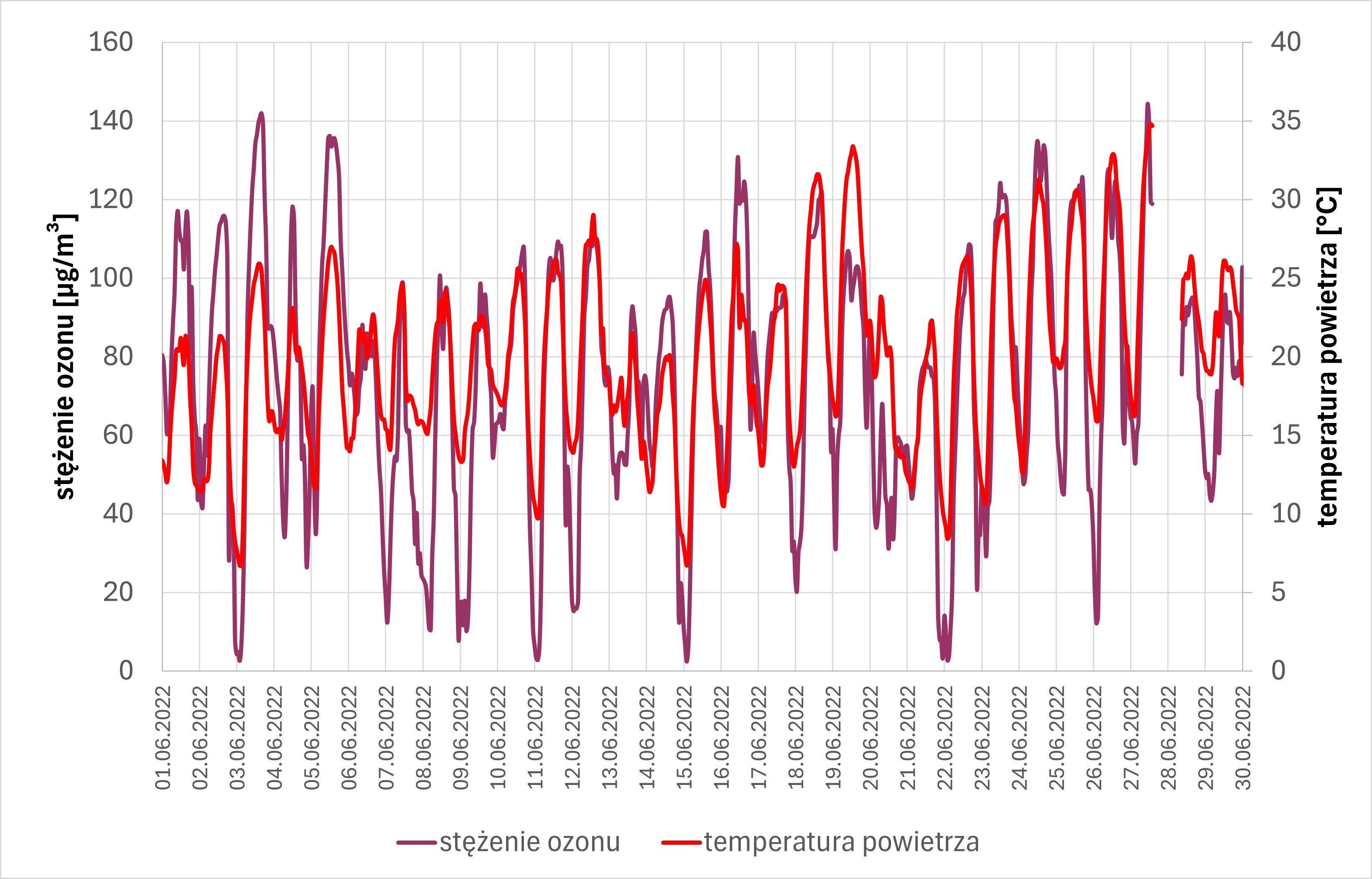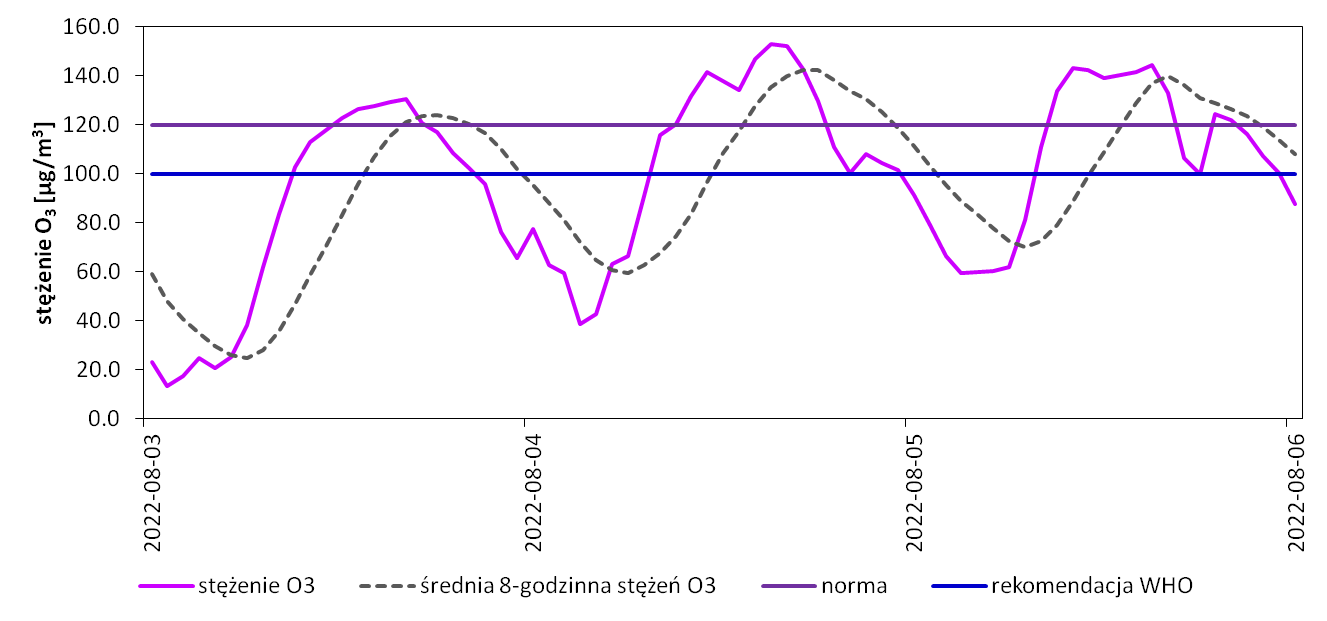Ozon

Ponieważ ozon jest silnym utleniaczem, wnikając do dróg oddechowych człowieka, powoduje ich podrażnienie i dyskomfort w oddychaniu. Krótkotrwała ekspozycja na wysokie stężenia może stanowić przyczynę stanów zapalnych dróg oddechowych. Długotrwałe lub powtarzające się narażenie mogą skutkować nasileniem objawów. Narażenie na ozon jest szczególnie niebezpieczne dla osób cierpiących na schorzenia układu oddechowego oraz osoby o obniżonej odporności organizmu, przede wszystkim osoby starsze i dzieci.
Ozon jest zanieczyszczeniem wtórnym, co oznacza, że nie jest emitowany do atmosfery, lecz tworzy się w powietrzu w wyniku reakcji tlenków azotu (NO i NO2) i lotnych związków organicznych (LZO) pod wpływem słońca. Związki te nazywamy prekursorami ozonu. Tlenek (NO) i dwutlenek azotu (NO2) są emitowane głównie przez transport kołowy oraz przemysł, natomiast emisja antropogeniczna lotnych związków organicznych jest również związana z procesami przemysłowymi. Duże stężenia tych substancji umożliwiają powstawanie ozonu, dlatego jego najwyższe stężenia obserwujemy na obszarach miejskich i podmiejskich.
Ze względu na charakter reakcji tworzenia ozonu, wysokie stężenia występują w słoneczne i ciepłe dni o słabym wietrze, z najwyższymi stężeniami w godzinach popołudniowych. Wysokie stężenia ozonu w Polsce występują w okresie od marca do września, najczęściej przy pogodzie wyżowej. Przekroczenia poziomu docelowego, wynoszącego 120 µg/m3 (średnia krocząca 8-godzinna) są obserwowane najczęściej w lipcu i sierpniu. Ze względu na silną zależność od warunków pogodowych, częstość występowania wysokich stężeń ozonu w kolejnych latach może się znacznie różnić. Poniżej przykładowy wykres stężeń dla stacji miejskiej (Wrocław, ul. Korzeniowskiego) w sierpniu 2015 roku, kiedy zanotowano przekroczenie progu informowania społeczeństwa.

Ryc. Średnie 1-godzinne stężenia ozonu oraz średnie godzinowe wartości temperatury powietrza, odnotowane w dniach 01-30.06.2022, w Obserwatorium ZKiOA IGRR UWr
Jak określamy przekroczenia norm dla ozonu?, Określanie przekroczeń norm dla stężeń ozonu odbywa się nieco inaczej, niż dla stężeń takich substancji jak pył zawieszony czy tlenki azotu. W ich przypadku przekroczenia norm odnosimy do średniej dobowej lub rocznej (jeśli wartość średniej, wyliczonej dla danej doby, lub roku przekracza wartość zdefiniowaną normą, mówimy o jej przekroczeniu.
W przypadku ozonu przekroczenia norm określa się nieco inaczej. Jak podaje portal GIOŚ, wartość odniesienia dla normy to:
Maksymalna średnia ośmiogodzinna spośród średnich kroczących, obliczanych ze średnich jednogodzinnych w ciągu doby. Każdą tak obliczoną średnią 8-godzinną przypisuje się dobie, w której się ona kończy. Pierwszym okresem obliczeniowym dla każdej doby jest okres od godziny 1700 dnia poprzedniego do godziny 0100 danego dnia. Ostatnim okresem obliczeniowym dla każdej doby jest okres od godziny 1600 do 2400 tego dnia czasu środkowoeuropejskiego CET.
Tak więc, jeśli maksymalna wartość średniej 8-godzinnej wyliczonej w danej dobie przekracza 120 µg/m3 mówimy że norma została przekroczona. Z tego powodu, na wykresach na których chcemy pokazać relacje między mierzonymi stężeniami a wartościami normatywnymi pojawia się dodatkowa linia, prezentująca wartości 8-godzinnej średniej ruchomej, wyliczanej tak, jak podano powyżej.
Analogicznie określane są przekroczenia rekomendacji WHO dla ozonu, z tym że wartość graniczna rekomendacji jest niższa i wynosi 100 µg/m3.
Różnice między wynikami pomiarów - stężeniami 1-godzinnymi ozonu, średnimi 8-godzinnymi oraz wartościami granicznymi dla normy i rekomendacji WHO, dla stężeń ozonu, odnotowanych w dniach 3 - 5 sierpnia 2022, we Wrocławiu przedstawia wykres poniżej.

Fig. Średnie godzinne oraz 8-godzinne stężenia ozonu, na tle wartości granicznych dla normy oraz rekomendacji WHO, odnotowane w dniach 3-5 sierpnia 2022 w Obserwatorium ZKiOA IGRR UWr
autor tekstu: Kinga Wałaszek, aktualizacja T. Sawiński






